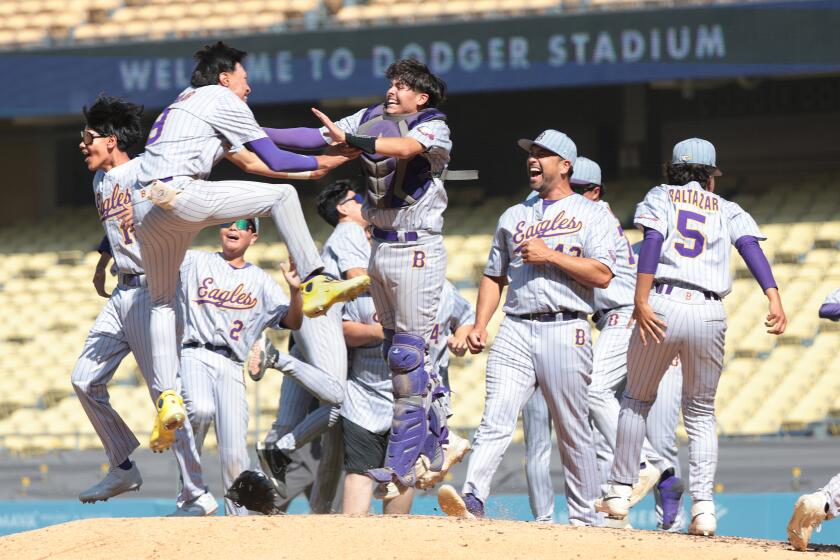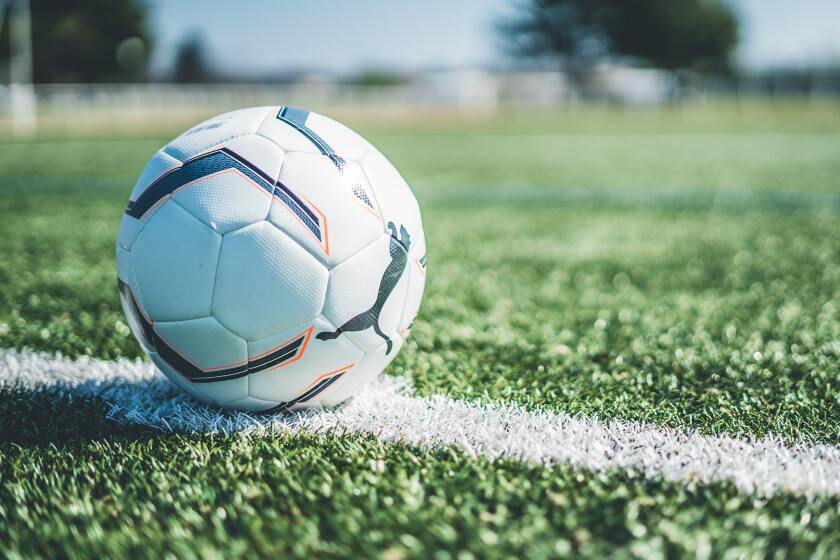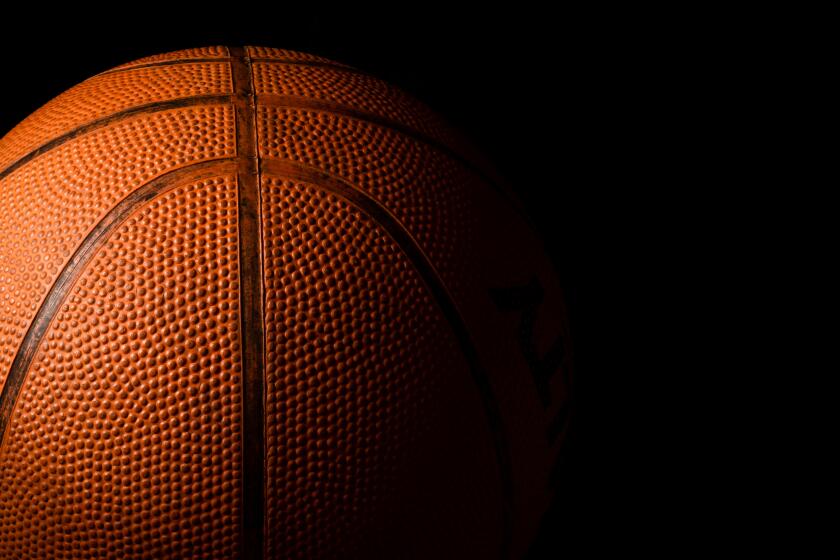A rivalry reviewed
- Share via
In the rest of the country, the apex of college football rivalries came a few weeks ago, when the so-so
Ohio State Buckeyes upset the nationally ranked Michigan Wolverines, and the Florida Gators upset Florida State’s Seminoles (ranked No. 10 that week). But in Los Angeles, our cross-town faceoff happens Saturday. The undefeated USC Trojans, on their determined march toward the national championship, have to make it past the 6-4 UCLA Bruins. No problem, you say? That’s what the Wolverines thought.
There’s more than bowl berths at stake. There’s pride. Conference records and Heisman candidates matter little when emotions run this high. This isn’t just a gridiron rivalry, after all, it’s one that’s played out in license-plate frames on the freeway and ball caps in Home Depot.
We asked The Times’ arts, entertainment and style critics to handicap the game by looking at it through the filters of their respective fields of expertise. Who should win if fashion dictated? What do the fight songs tell us? Which quarterback has the grace of a ballerina?
Let the bookies and sportswriters set their point spreads; our method is just as likely to be accurate.
If you’re among the 91,136 people with a seat at the Rose Bowl on Saturday, enjoy. If not, the game’s at 1:30 p.m. on ABC.
*
Lords of the dance
A prime postmodern principle teaches us that any movement can be construed as dance. So it’s not farfetched to size up the quarterbacks, USC’s Matt Leinart and UCLA’s Drew Olson, based on their moves.
Ringed with Trojan muscle, Leinart takes his time to calmly decide who deserves the ball on each play. “I’ve always kind of liked pressure situations,” he told FSN West earlier this season, and he almost always exudes confident self-control. Indeed, he moves no more than necessary, all his power kept in reserve. If he were a dancer, he’d be an aristocratic ballet prince -- maybe Apollo, majestically driving the horses of the sun.
In contrast, Olson would be a twitchy, twisty, impulsive Twyla Tharp virtuoso. His style is dangerously unpredictable. UCLA’s defense has been, shall we say, inconsistent this season, so Olson’s mastery of the running/dodging fake-out may count as adaptive behavior. But it’s great fun to watch him improvise: five steps back, pause, then two steps for a phony handoff, a shuffle into a new position and finally a lunge into a pass.
It’s a slight exaggeration to label Leinart a poised classical quarterback and Olson an edgy modernist -- but only slightly. As Martha Graham definitively observed, movement never lies.
Final score: Tie game.
-- Lewis Segal
*
Designer tags
When Red Sanders came to UCLA for the 1949 season, he redesigned the Bruin uniforms, adding a gold loop on the shoulders and changing the navy blue to a lighter shade so it would look better on the field and on film. He dubbed it “Powder Keg Blue” -- powder blue with an explosive kick. Sports Illustrated has named the uniforms the best-looking in college football. The home jerseys -- with numbers outlined in white and sunshine gold shoulder stripes -- bring to mind surf graphics, befitting a school just five miles from the Pacific. But the loopy script “UCLA” on the helmets evokes a kind of “whatever, dude” mentality. Bottom line: These uniforms may be too good looking; less Bruin, more surf bunny.
Across town, USC’s campus may have stood in for Harvard in “Legally Blonde,” but Elle Woods wouldn’t go near these “Let’s Get Physical” uniforms. The luster on the Trojans’ gold spandex pants doesn’t recall the Greek gods of Olympia, but the Jane Fonda-fueled ‘80s aerobics craze. As for their away jerseys, white may be the color of victory, and it does show off that Nike swoosh, but hello grass stains. A few tackles and the players look as if they’ve already taken a beating. But maybe that’s the point. With red helmets and shoulder stripes conjuring war paint, there is a hefty intimidation factor.
Final score: USC 34, UCLA 26.
Booth Moore
*
Fight songs both flowery and fierce
We are Sons of Westwood
And we hail the Blue and Gold
True to thee our hearts will be,
Our love will not grow old.
That was the fight song at UCLA when I was a student there in the ‘60s, and apparently it, like me, survives. Hearing it now (actually for the first time), on the Internet at the site of the UCLA History Project, my love grows old. Excuse me, but our fight songs were by Jimi Hendrix and Bob Dylan.
UCLA’s fight songs also include an antique ditty, “Hail to the Hills of Westwood” (hills?), written in 1925 by an undergraduate whose only distinction was being female. The USC band, on the other hand, sticks to basic war themes: “Fight On!” That slick number brings to mind other hills -- Hollywood’s. USC’s “Tribute to Troy” could even be from a Trojan War tin epic.
So let the cheering roar, heads knock, beer be swug. But don’t expect the Bruins to be Greeks bearing musical gifts, nor the Trojans to be wanting any. Then again, who goes to football for the music?
Final score: Bruins 0; Trojans 0 -- and penalties galore.
-- Mark Swed
*
Stadiums of yore
Any architectural battle between our two college football stadiums is a fight you’d want to break up out of concern for their safety. The Rose Bowl, which was finished in 1922, and the Coliseum, which hosted its first game a year later, are both now in their 80s and a bit creaky and wrinkled even after several face-lifts. Still, few places offer football surrounded by as much charm or history. Between them, the stadiums have hosted seven Super Bowls, two World Cup finals and one papal Mass.
The Rose Bowl, by architect Myron Hunt, scores most of its points with its setting. Tucked into Pasadena’s Arroyo Seco, it provides a vista matched in the Pac-10 only by the stadiums in Seattle and Berkeley -- a plus when the Bruins’ Charmin-soft run defense forces fans to avert their eyes from the field.
The Coliseum, designed by John Parkinson, gives new meaning to “cavernous,” even though its capacity of 92,000 is almost equal to the Rose Bowl’s. The Roman vibe produced by the Mussolini-meets-Moderne colonnade is great when the place is packed -- and nicely fits the Trojan theme -- but in what other stadium can you feel lonely when the attendance is 75,000? You need not only binoculars but also hiking boots if you’re sitting near the top.
Final score: UCLA 23, USC 17.
-- Christopher Hawthorne
*
Drama high and low
USC comes in undefeated, a juggernaut, 11-0, ranked No. 1 all season in the BCS standings, the only thing standing between it and the national title game a mediocre, erratic team from the Westside of Los Angeles.
In fact, due to a quirk in this year’s scheduling, USC is facing UCLA several weeks later than the usual mid-November game. For USC, then, Saturday’s game is like a layover on its way to Miami to play in the Orange Bowl on Jan. 4.
But think about what happens on a layover. Flights are delayed, plans get messed up.
USC has a quarterback who’s a Heisman Trophy candidate, and its coach is a former NFL tactician. It beats teams with a breathtaking, multifaceted offense. UCLA, on the other hand, has a quarterback who is not a candidate for any trophy, and its coach has been a head coach for only two seasons. UCLA does not beat teams with a breathtaking offense. It beats them with a lukewarm ambivalence, offering to give back the game.
But this is precisely why all those USC fans loading up their Lexus SUVs in Newport Beach for the trek to Pasadena should be worried. Nothing good can happen on this trip to Pasadena, only what is expected to happen.
I say this, of course, as a UCLA fan. Lukewarm. Ambivalent. Probably they’ll lose.
Final score: UCLA 36, USC 31 (unless it doesn’t work out at all, in which case I change my prediction to USC 41, UCLA 13).
-- Paul Brownfield
*
It’s just a game, right?
Let the critics guess. I know the results. I paired off USC and UCLA on my PlayStation2. (One caveat: The video game lacks real-life star players; these are amateur athletes, after all.)
Here’s the recap, to be read aloud in your best Keith Jackson announcer voice: “Whoa doctor! UCLA narrowly missed its shot at a huge upset, falling to USC, 10-7. Despite pregame predictions of a monster performance from Trojan halfback No. 5, UCLA’s defense held him to just 52 yards on 13 carries.
“Neither team could gain much offensive momentum. UCLA completed a 66-yard drive that resulted in a touchdown pass to Bruin tight end No. 8. But USC’s touchdown -- scored on an interception return by cornerback No. 23 -- and 25-yard field goal in the third quarter wrapped it up.
“All that was left was the coach’s Gatorade shower, lead by USC’s quarterback, No. 11. A fitting end to a tilt for the ages.”
Final score: USC 10, UCLA 7.
-- Pete Metzger
More to Read
Go beyond the scoreboard
Get the latest on L.A.'s teams in the daily Sports Report newsletter.
You may occasionally receive promotional content from the Los Angeles Times.










